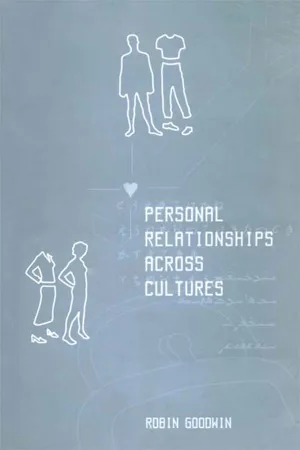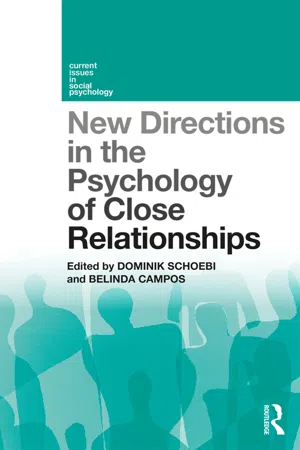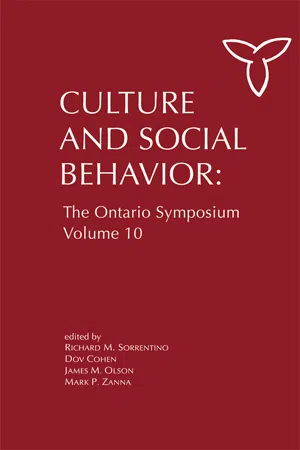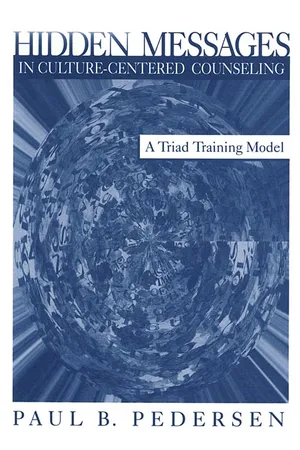Psychology
Cultural Differences in Relationships
Cultural differences in relationships refer to the varying norms, values, and communication styles that exist across different cultures and can impact how individuals form and maintain relationships. These differences can influence aspects such as gender roles, conflict resolution, and expressions of love and affection, and understanding them is crucial for promoting healthy and successful cross-cultural relationships.
Written by Perlego with AI-assistance
Related key terms
1 of 5
6 Key excerpts on "Cultural Differences in Relationships"
- eBook - ePub
- Robin Goodwin(Author)
- 2013(Publication Date)
- Routledge(Publisher)
1 The development of research into personal relationships across cultures
Introduction
To begin to understand how relationships vary across cultures, we need first to define our terms. As I will argue below, however, defining ‘relationship’ or ‘culture’ is more complex than we might at first imagine, and the kinds of definitions used reflect the type of research which has been conducted. I then go on to describe how particular Western conceptualisations of relationships have restricted the range of relationships examined, this narrowness of focus being just one of the reasons why we might benefit from a broader, more cross-cultural analysis. Unfortunately, this cross-cultural work in itself has often been simplistic in design, mimicking Western ideas and methods. Instead, I will argue that understanding personal relationships across cultures means looking at the nature of people's daily existence in the context of a whole range of historical, social and political factors.Defining our terms: ‘personal relationships’ and ‘culture’
Personal relationships
What is a ‘personal relationship’? When relationship researchers present their considerations of personal relationships, they rarely define their terms. In one of the best-known definitions, Argyle and Henderson describe a personal relationship as a ‘regular social encounter over a period of time’ (Argyle and Henderson, 1985: 4). A personal relationship is usually seen as one of considerable duration (Kelley et al., 1983), involving a great degree of interdependence of emotions and thoughts (Berscheid, 1994; Kelley et al., 1983) and evolving through a negotiated set of disclosures (Altman and Taylor, 1973).Unfortunately, such definitions omit perhaps the most critical feature of relationships in Eastern cultures – the centrality of role obligations (Yang, 1995). Such obligations do not necessarily relate to simple frequency of interaction: your relationship with a teacher in an Eastern culture, for example, may remain similar regardless of the number of the interactions you enjoy. Definitions which focus on interdependent thoughts and feelings also tend to neglect the perceptions of others outside of the relationship, ignoring the social stage upon which relationships are performed (Goffman, 1959). These others may play a central part in defining any interaction as a relationship: where there are strict prescriptions about pre-marital encounters, for example, any meeting between the sexes may be defined as a potentially dangerous ‘relationship’. Finally, more recent conceptualisations of relationships, particularly those emerging from the literature on social networks, have identified the role of ‘weak ties’ in linking individuals to other social networks. These may be potentially of great significance during certain pivotal life stages (Trickett and Buchanan, 1997). Reflecting my interest in the centrality of these cultural prescriptions and perceptions, I consider a personal relationship to be the interaction between two or more individuals located within the context of wider societal and cultural forces. - eBook - ePub
Foundations for Couples' Therapy
Research for the Real World
- Jennifer Fitzgerald(Author)
- 2017(Publication Date)
- Routledge(Publisher)
Intercultural couple relationships have historically been unusual and formed against the wishes of the partners’ families and societies. In some places, these relationships were even against the law. However, in recent years the world’s population has become increasingly mobile and connected, and attitudes are changing. Rapid increases in intercultural marriage rates have been reported around the world. However, there is evidence that intercultural couples still face greater difficulties than intra-cultural couples. Intercultural couples are at higher risk of divorce than intra-cultural couples, and this risk increases with the extent of difference between the partners’ cultures (Kalmijn, de Graaf, & Janssen, 2005). Therefore, it is essential for couple therapists to acquire knowledge and skills to assist this growing population.Cultural Differences in Couple Relationships
The dimensions of individualism and collectivism provide a simple framework via which cultural differences in couple relationships can be understood. In individualistic cultures, people are perceived as separate beings whose behaviour is primarily determined by internal attributes (Markus & Kitayama, 1991). Young people are expected to develop independence and discover and express their unique abilities, ideas, feelings and preferences. People are defined by their individual characteristics, and validation of these forms the basis of self-esteem. In contrast, in collectivistic cultures, people are defined by their relationships with others (Markus & Kitayama, 1991). Behaviour is determined by perceptions of others’ thoughts, feelings and actions, and self-esteem is derived from fitting harmoniously into the group. Suppression of individuality for the sake of group harmony is regarded as a sign of maturity. International studies indicate that European countries and former European colonies tend to be high in individualism, while Asian, African and Latin-American countries tend to be high in collectivism (see e.g., Hofstede, Hofstede, & Minkov, 2010).These cultural differences in values give rise to different relationship standards. Romantic love is central to the Western conceptualization of a good couple relationship. Falling in love is considered the first step of a couple relationship and lack of love a reason for ending it. This is likely to be due to the value placed on self-determination and pursuit of individual fulfilment in individualistic cultures. Therefore, keeping romance alive in the relationship is considered an important task for partners and is a component of many Western couple therapies. - Dominik Schoebi, Belinda Campos(Authors)
- 2019(Publication Date)
- Routledge(Publisher)
People in different cultures have different objectives and ideals in close relationships. Yet, relationship research has often failed to take this variation into account. In fact, much of the research on close relationships started from universalist assumptions based on individuation and separation as being universal trajectories across relationship contexts. In the present chapter, I demonstrated what it might mean for close relationship research if it did question universality. To this aim, I showed for a selection of relational processes that cultural variation not only exists, but that cultural variation—at least in a comparison of North American/Western European and East Asian contexts—is systematic und can be understood from the relative cultural foregrounding of an independent versus and interdependent mode of relating. How people establish secure attachment, how they form and structure romantic relationships, how they handle conflict, and, finally, which emotions play a central role in their close relationships all varies between cultures along the lines of independence and interdependence.To date, research on cultural differences in close relationships is relatively limited and receives only scant attention. For example, only two out of 37 chapters in the recent Oxford handbook of close relationships focused on the role of culture in close relationships (Simpson & Campbell, 2013). In fact, much of the relational research that is available focuses on convenience samples of friends or non-acquainted strangers. I believe that much can be gained by studying cultural variation in relational processes in close relationships, as these are the relationships in which cultural meanings are most commonly passed on, instantiated, and negotiated. In my view, studying cultural variation in relational processes would benefit relationship science as well as cultural psychology: It would not only lead to an appreciation of the many ways in which people form and manage close relationships across cultures, but research on the cultural underpinning of close relationships would also allow cultural psychologists to better understand the “making” of culture, e.g., by studying the microgenesis of how cultural differences emerge during actual interactions (rather than merely demonstrating that- eBook - ePub
- Miles Hewstone, Wolfgang Stroebe, Klaus Jonas, Miles Hewstone, Wolfgang Stroebe, Klaus Jonas(Authors)
- 2016(Publication Date)
- BPS Blackwell(Publisher)
Völkerpsychologie (normally translated as ‘folk psychology’), which included discussion of differing cultures around the world. More recently psychologists have discussed cultural differences in terms of variations in attitudes, values and beliefs. These variations can contribute to our understanding of the concept of culture if we take them into account. In the remainder of this chapter, we examine studies that are relevant to issues that have been discussed in preceding chapters, particularly in relation to social cognition, self-concept, personal relationships, group behaviour and intergroup relations. In each of these areas we will show how attention to cultural differences can enrich our understanding of social psychological processes.CULTURE AND CULTURAL DIFFERENCES
What is culture and why should we study it?
The opening chapter of this book discusses some of the best-known and frequently discussed social psychology experiments. Most of these experiments were conducted in the United States and some in the United Kingdom. What would happen if they were repeated somewhere else in the world? We can answer this question, because there have been attempts at cross-cultural replication of all these studies, some of them many times. Consider first an early study of group dynamics that was published by Schachter (1951). In this study, Schachter set up a series of student discussion groups. Unknown to most group members, each group contained an accomplice of the experimenter. The accomplice (the ‘deviate’) was instructed to take up a position opposed to the views of the majority and stick to his position. Schachter predicted that the deviate would over time receive less and less attention and be rejected by the group, which is just what he found among his US respondents.cross-cultural replication a test of whether the results of a study are the same if it is repeated as exactly as possible in another cultural context.A few years later, Schachter and seven colleagues (1954) reported on the results of a slightly different version of this study that was conducted in seven different European nations. In this case, groups of 11-year-old schoolboys were asked to decide which of several model aeroplanes to build. The results were complex and not at all as the experimenters had predicted. The groups in France did almost all reach agreement and did reject the deviate, as predicted. However, many of the groups in Belgium, West Germany (as it was then known) and the UK did not reach agreement at all, and ratings on a 7-point scale as to whether the deviate should leave the group varied greatly between nations, as shown in Figure 15.1 - eBook - ePub
Culture and Social Behavior
The Ontario Symposium, Volume 10
- Richard M. Sorrentino, Dov Cohen, James M. Olson, Mark P. Zanna(Authors)
- 2005(Publication Date)
- Psychology Press(Publisher)
Chapter 4Culture and Relationships: The Downside of Self-Contained Individualism
Kenneth L.Dion and Karen K.Dion, University of TorontoOur work has focused on cultural perspectives on heterosexual love, including issues pertaining to love and interdependence and love and views of self. When we first considered these issues in the 1980s (K.L.Dion & K.K.Dion, 1988), little research was being conducted on the cultural context of close relationships by social or crosscultural psychologists in Canada or the United States, who studied topics such as attraction, love, relationship development, or relationship maintenance. We contended, then as now, that social psychological phenomena such as love and intimate relationships can be more fully understood by considering the societal and cultural context, particularly family structure and societal norms pertaining to close relationships.The statement that “They met, fell wildly in love, married (or cohabited) and hoped to live happily ever after” exemplifies one (indeed, several) cultural scripts, rather than necessarily being a universal description of the nature and sequence of adult pair-bonding. Consider the following statement provided by a young woman describing the development of her relationship with her fiancé: “We never talked about the word love when we saw each other; therefore I trust him deeply and respect him very much.” The young woman was Chinese; the quote is from Hsu’s (1981) analysis of the different connotations of the word love in traditional Chinese society, as contrasted with what he characterized as the North American view of love. Hsu suggested that when thinking of romantic love: “An American asks, “How does my heart feel?” From the perspective of Chinese cultural traditions, an individual would ask: “What will other people say?” ”Many, if not all, cultures contain folk tales and stories of passionate love attachments. In some cases, however, these are cautionary tales, not tales of ideal relationships. We have argued in various papers and presentations over the past 15 years (K.K.Dion & K.L.Dion, 1991, 1993, 1996a, 1996b; K.L.Dion & K. K.Dion, 1993) that the sociocultural constructs of individualism and collectivism have relevance for understanding the psychology of love and different cultural scripts for romantic love. The aforementioned quote from Hsu, in fact, nicely captures how the meaning of a close personal relationship such as heterosexual marriage can be interpreted very differently depending on the relative emphasis on fulfilling personal desires and one’s obligations to others. - eBook - PDF
Hidden Messages in Culture-Centered Counseling
A Triad Training Model
- Paul B. Pedersen(Author)
- 1999(Publication Date)
- SAGE Publications, Inc(Publisher)
13 The Foundation of Counseling Relationships PERSONAL Ethnographic (nationality, eth-nicity, religion, language, etc.) BEHAVIOR EXPECTA-TIONS VALUE Demographic (age, residence, physical ability, etc.) Status (social, economic, politi-cal, educational, etc.) Affiliation (formal like family or informal like a shared idea) Figure 1.1. The Intrapersonal Cultural Grid for Describing Within-Group or -Person Variables SOCIAL SYSTEMS BEHAVIORS Same Different 1 Shared Positive 2 Cultural Conflict loud/quiet Same/Positive Expectations open/closed Trust direct/indirect Respect formal/informal Fairness close/distance Efficiency task/relationship EXPECTATIONS Effectiveness Safety Different/ 3 Personal Conflict 4 War Negative Figure 1.2. The Interpersonal Cultural Grid for Describing Between-Group or -Person Variables 14 H I D D E N M E S S A G E S IN C O U N S E L I N G time as the relationship changes. We see the behavior, but the expectations, values, and social systems in which that behavior was learned may be hidden from us. In the first quadrant, two individuals display similar behaviors (e.g., smil-ing) and have similar positive expectations (e.g., for friendship). The relation-ship is congruent and harmonious. There is a high level of accuracy in both individuals' interpretations of one another's behavior and in the shared posi-tive expectations behind their behavior. The overt, explicit, and interpersonal interaction is congruent with the covert, implicit, and intrapersonal expecta-tions. There is little conflict in this quadrant, and the relationship can be described as comfortable. In the second quadrant, two individuals have different behaviors but share the same positive expectations. There is a high level of agreement in that both persons expect trust and friendliness, for example, but there is a potentially low level of accuracy. Each person perceives and incorrectly interprets the other's behavior as different and probably hostile.
Index pages curate the most relevant extracts from our library of academic textbooks. They’ve been created using an in-house natural language model (NLM), each adding context and meaning to key research topics.





